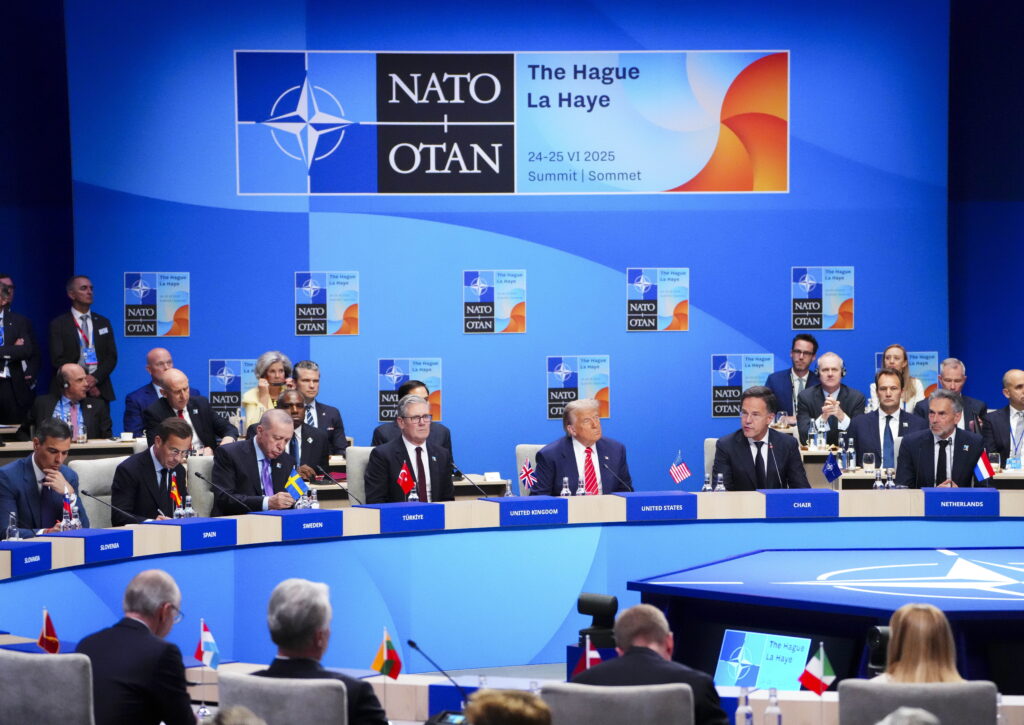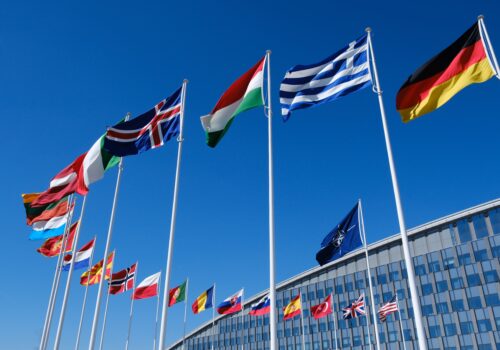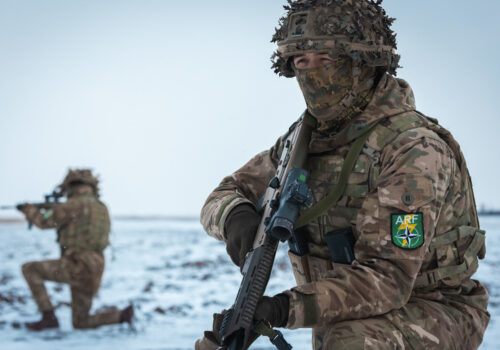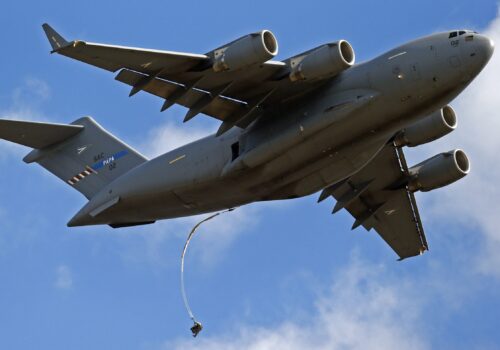In Dutch, haag, from which The Hague gets its name, means hedge. It’s perhaps fitting, then, that when NATO leaders met in The Hague this week, there were several hedges. Allies sought to hedge against an unpredictable US president by limiting the summit’s scope. They also hedged against the United States reducing its commitment to the Alliance by promising to increase defense and defense-related spending to 5 percent of gross domestic product (GDP) by 2035. And they hedged—as in avoided a direct answer—on the central issue of Russia’s ongoing war in Ukraine.
Below, Atlantic Council experts dig into the details of what happened in the Netherlands over the past two days and what’s next for the Alliance.
Click to jump to an expert analysis:
Ian Brzezinski: Even with the ‘5 percent’ success, no new substantive action was taken on Russia
John E. Herbst: Though Ukraine was relegated to a side event, there were signs of progress
Daniel Fried: Trump got a win, and NATO got the resources it needs
Philippe Dickinson: The Hague Declaration is diplomatic haiku
Torrey Taussig: The summit succeeded on its primary aims, but avoided critical questions
Rachel Rizzo: Will European leaders spend the political capital needed to reach 5 percent?
Rob Murray: Allies will need to rewire their financial architecture to reach 5 percent
John R. Deni: The focused communiqué caps a successful summit, but there are causes for concern
Andrew Bernard: Spain digs a deeper credibility hole
Ryan Arick: NATO (finally) recognizes the importance of industry
Even with the ‘5 percent’ success, no new substantive action was taken on Russia
NATO’s summit at The Hague will be remembered both for what was and what wasn’t said and done.
The commitment by NATO heads of state to allocate a minimum of 5 percent of GDP each year “on core defence requirements as well as defence- and security-related spending by 2035” promises to significantly increase allied, particularly European, military capacities. Fulfilling that pledge is critical to operationalizing NATO’s new regional defense plans to deter Russian aggression. That was a clear success for US President Donald Trump and for the Alliance as a whole.
But what was not left clear was the future of US commitment to European security. While the United States agreed to communiqué language that reaffirmed an “ironclad commitment to collective defence as enshrined in Article 5 of the Washington Treaty,” little was communicated by Trump about the future of US force posture in Europe. Since his inauguration in January, his administration has repeatedly signaled its intent to draw down US forces in Europe in order to reinforce US interests in the Indo-Pacific and the Western Hemisphere. A significant drawdown could profoundly affect the distribution of allied force commitments that underpin NATO’s new regional defense plans.
More importantly, the NATO Summit convened as Russia brutally escalates its invasion of Ukraine. Yet the summit yielded no new substantive action against Russian President Vladimir Putin’s aggression. Instead, the United States blocked a long-planned effort to promulgate at the summit an Alliance strategy against Russia; US Secretary of State Marco Rubio reiterated US opposition to imposing new economic sanctions on Russia; and Trump publicly balked on providing Ukraine a new tranche of security assistance.
The United States’ absence of action against Russia at The Hague summit matters. There is no clearer and immediate indication of commitment to transatlantic security than what a NATO ally does or does not do to support Ukraine against Russia’s ongoing invasion.
—Ian Brzezinski is a resident senior fellow with the Scowcroft Center for Strategy and Security and former US deputy secretary of defense for Europe and NATO policy.
Though Ukraine was relegated to a side event, there were signs of progress
There was much sound and fury in the lead-up to and preparation for the NATO Summit relating to two key questions of NATO and US policy toward Russia and the war on Ukraine. Reflecting the ad hoc nature of Trump’s approach to Russia and the war, the results of the week are mixed but on balance positive. The two downsides come from steps NATO took to avoid a blowup with Trump. At its 2024 summit, NATO decided that it needed a new strategic policy to address the dangers Moscow poses. Many NATO leaders believe, along with Ukrainian President Volodymyr Zelenskyy, that a Russian win in Ukraine could be followed by severe provocations and worse against NATO members. But to avoid setting off the US president, NATO decided months ago to shelve the effort to write a new approach. For the same reason, NATO also decided to limit the role of the Ukrainian president to side events. Both steps, taken as Ukraine faces the most savage Russian bombing campaign of the war, could only be welcome in Moscow.
This was offset by the mention in the summit communiqué that European defense contributions to Ukraine would count toward the new defense spending requirements for NATO. Moscow was also likely not pleased with Trump’s post-summit press conference. In it, he expressed his understanding of Ukraine’s need for air defense and promised to see what he could do about getting additional air defense systems to Ukraine.
Also on the plus side was the commitment made toward meeting Trump’s goal of increasing defense spending to 5 percent by 2035. This was sharply criticized by Putin’s press spokesman Dmitri Peskov as dangerous and having required the West to “conjure up a demonic threat.” It’s important, too, that the summit communiqué linked this increase to the Russian threat to NATO.
Trump also made clear that he recognizes that Putin is the obstacle to peace. Twice in less than a week, the Russian president offered to help negotiate an end to the conflict between Israel and Iran. Each time, Trump declined and suggested that Putin pay attention to ending the war in Ukraine. Trump emphasized this point again in his post-summit press conference. While recognizing this, Trump has still proved reluctant to put pressure on the Kremlin, and the US Senate sanctions bill with eighty-four cosponsors is still on hold, waiting for a nod from the White House. Moreover, Rubio said at The Hague that now was not the time to put new sanctions on Russia because it would persuade the Kremlin not to engage in peace talks. That analysis is exactly wrong and out of step with the numerous statements from Trump that he would put pressure on the party obstructing peace. Only pressure might persuade Putin—who recently said that Russia has a right to take all of Ukraine—to negotiate Trump’s long-declared goal of a stable peace.
—John E. Herbst is the senior director of the Atlantic Council’s Eurasia Center and a former US ambassador to Ukraine.
Trump got a win, and NATO got the resources it needs
It wasn’t glorious. But sometimes good enough is what you need. The NATO Summit Declaration recognized explicitly the threat from Russia and reaffirmed Article 5’s collective defense commitment without qualification; committed allies to a 3.5 percent plus 1.5 percent increase in defense and defense-related spending, respectively, by 2035; and reaffirmed allies’ commitments to contribute to Ukraine’s defense and defense industry. That’s a fair set of achievements, especially when set against the more dire predictions of a blow-up or a no-show by Trump, or a deadlock.
Trump suggested he was happy to take the win as opposed to moving the goalposts. Before the summit, Trump had made ambiguous remarks about Article 5; at his summit press conference, Trump spoke with respect about the patriotism he sensed from his fellow NATO leaders and remarked that “they need the United States. And we’re here to help them protect their country.”
After meeting with Zelenskyy, Trump left open the possibility of providing more funds and Patriot batteries for Ukraine’s defense, but he could have (and should have) gone further, for example by reraising his proposal for a thirty-day unconditional cease-fire, threatening Russia with hard new sanctions if Putin does not agree, and committing to provide Ukraine with a steady flow of US weapons one way or another. Still, Trump moved from chilly hostility to Ukraine’s fight for survival back to a supportive mode.
The Trump administration had been making the case that NATO’s members had to contribute a lot more for the common defense and that, absent real commitment to do so, the United States could not be counted on to keep picking up the slack. The combination of the Russian threat and Trump pressure (mostly the former) has finally registered with key Western Europeans who have acknowledged that the Americans were right about lagging European defense spending and that the Poles and Baltic countries (and others in Europe’s east) were right about the threat from Russia. Late, but hopefully not too late, Europe is standing up its strategic capacity. That, it seems, registered with Trump and his team.
NATO Secretary General Mark Rutte has been working to convince Trump that NATO could deliver. He took some criticism for his flattery of Trump, but he appears to have made the right call. US Permanent Representative to NATO Matthew G. Whitaker seems to have been working to land the deal and have Trump take the win. They and their teams delivered. Trump gets his win, NATO gets needed resources, and the United States stays in. Good enough.
—Daniel Fried is the Weiser Family distinguished fellow at the Atlantic Council and a former US ambassador to Poland.
The Hague Declaration is diplomatic haiku
Brevity may be the soul of wit, but it is not typically the custom of diplomacy. Summit statements are usually painstakingly negotiated at length over several months, to make sure everyone’s priority concern is addressed through elaborately layered language. Not this year. At only five paragraphs and 427 words, The Hague Declaration is diplomatic haiku.
The brevity reflects the changed transatlantic political context. Last year, the Washington Declaration ran to 5,341 words, with extensive and detailed sections covering defense modernization efforts, support for Ukraine, and the wider strategic challenge posed by China, Iran, and North Korea. This year, there is no mention of China, Iran, or North Korea, a reflection of the apparent prevailing view in the Pentagon that the respective theaters should not be linked. Support for Ukraine is briefly referred to as sovereign commitments made by individual allies. Like all good haiku, The Hague Declaration conveys an unmistakable emotional truth. This is an Alliance that dances to Trump’s tune. Its number one priority is his priority—getting the Europeans to spend more.
But for the new NATO secretary general, Rutte, this is nevertheless a successful outcome. The communiqué reaffirms the “ironclad” commitment to Article 5 and names Russia as the foremost security threat. Moreover, the summit produced no uncomfortable confrontations with Trump. And the remarkable leap in spending ambition should not be obscured by the late negotiations about carve-outs for the Alliance’s spending laggards. For all the wider anxieties of the past few months, Rutte has achieved his top summit objective: keep Trump on board.
—Philippe Dickinson is a deputy director with the Transatlantic Security Initiative at the Atlantic Council’s Scowcroft Center for Strategy and Security. Prior to joining the Council, he was a career diplomat with the United Kingdom’s Foreign, Commonwealth and Development Office.
The summit succeeded on its primary aims, but avoided critical questions
This year’s NATO Summit had two primary aims: secure a bold new defense spending pledge and keep Trump happy. In these regards, the summit was a success. Despite pushback and an eventual exception for Spain, allies agreed to increase defense spending to 5 percent of GDP annually, including 3.5 percent toward military troops and equipment and 1.5 percent toward defense-related expenditures such as critical infrastructure and cybersecurity. Trump, in The Hague for less than twenty-four hours, issued glowing remarks toward his allied counterparts in his closing press conference, proving that Rutte’s strategy of heaping lavish praise on Trump in exchange for a smooth summit had worked.
Yet many of the most critical issues facing the Alliance were left off the table—including how NATO allies will support Ukraine, develop a clear-eyed strategy on Russia, and address evolving challenges from China. Looming over the summit was also uncertainty around the United States’ future political and military commitment to Europe. These critical challenges and uncertainties will be waiting for allied leaders when they return to their capitals following a seemingly calm summit in The Hague.
—Torrey Taussig is the director of and a senior fellow at the Transatlantic Security Initiative in the Atlantic Council’s Scowcroft Center for Strategy and Security. Previously, she was a director for European affairs on the National Security Council.
Will European leaders spend the political capital needed to reach 5 percent?
The NATO Summit communiqué, while short, tackles one of the greatest challenges facing the Alliance today, which is how Europe plans to beef up its defense spending as the United States geopolitically orients itself away from the old continent. The language, that allies “commit to invest 5 percent of GDP annually on core defence requirements as well as defence- and security-related spending by 2035,” doesn’t leave much wiggle room for failure. Although, at the same time, the language may leave just enough wiggle room for some allies (such as Spain) to opt out.
The question now is whether or not European leaders are willing to expend the political capital necessary to convince their publics that defense is worth spending on, especially if it comes out of other social spending budgets. I don’t think most people, especially in the US government, appreciate just how much of an ask that is. So, we should celebrate but also understand that now is where the hard work actually starts and that we actually have a long way to go to get defense spending up to the levels committed.
—Rachel Rizzo is a nonresident senior fellow at the Atlantic Council’s Europe Center.
Allies will need to rewire their financial architecture to reach 5 percent
The challenge with NATO’s 5 percent of GDP by 2035 defense pledge is not Spain’s domestic politics—it’s whether the Alliance can demonstrate a credible path to deliver on what it has promised. At the 2014 Wales summit, allies committed to reaching 2 percent of GDP by 2024. Most met that mark, but not all—and that’s the problem. When political commitments aren’t followed through with action, deterrence erodes. Our adversaries notice. So do our publics.
Avoiding that outcome at 5 percent requires more than rhetoric. It demands a clear, coordinated financial strategy—one that signals seriousness and ensures resources are spent effectively. That starts with redesigning the defense capital stack. Allies need to rewire the financial architecture that supports Western security to reflect the fact that they are no longer in peacetime: national export credit agencies must be activated, commercial banks incentivized, private equity and venture capital mobilized, and long-term institutional investors brought to the table.
A purpose-built multilateral Defense, Security, and Resilience Bank owned by allies should anchor this new architecture—providing guarantees, absorbing risk, and enabling capital to flow to the mid-tier firms and industrial suppliers they depend on but have undercapitalized for too long. But it’s not a silver bullet. This must be a system-wide mobilization of public and private finance.
The scale of the shift is vast: To get to 5 percent requires $1.9 trillion in additional annual spending across NATO. Without structural reform, that surge will drive inflation, not capacity. The signs are already there—155mm artillery shells that cost $2,000 before 2022 now exceed $8,000. Leopard 2 tanks sold to the Dutch for $23 million each in October 2024 were sold to Austria in February 2025 at $30 million per tank.
If 5 percent is to be more than a symbolic target, allies must build the financial tools to match their strategic ambition. That starts now—with action, not aspiration.
—Rob Murray is a nonresident senior fellow in the Forward Defense program and the Transatlantic Security Initiative within the Atlantic Council’s Scowcroft Center for Strategy and Security.
The focused communiqué caps a successful summit, but there are causes for concern
This year’s five-paragraph NATO summit communiqué is unprecedentedly short, completely unlike the thirty-eight-paragraph communiqué from last year’s summit in Washington or the ninety-paragraph behemoth agreed at Vilnius in 2023. In some respects, this is a welcome change, given the everything-under-the-sun approach of past communiqués, which seemingly cast NATO as unable and/or unwilling to prioritize.
In contrast, the Hague communiqué is certainly focused and, given the concerns of some regarding the nature of the United States’ relationship with NATO specifically and Europe more broadly, indicates that the summit was largely successful. Four elements of the communiqué underline this success, while three caveats present some reasons for concern.
First, the commitment to 5 percent defense spending—while requiring careful attention to ensure allies’ expenditures actually contribute to defense in meaningful ways—represents a significant improvement over the previous defense investment pledge of just 2 percent.
Second, and on a more inside-baseball level, the communiqué ties increased defense spending directly to agreed Alliance capability targets. These targets are based on allied operations plans for the defense of Europe and North America. Ultimately, this means increased allied spending should explicitly strengthen defense and deterrence.
Third, the communiqué clearly places Russia at the center of allied security concerns, where it belongs—Moscow remains the greatest threat to European (and hence American) security and stability, with the demonstrated potential and stated intent to undermine Western interests, unity, and prosperity.
Fourth, allies highlighted the importance of continuing aid to Ukraine and the clear, explicit linkage between its security and that of Europe and North America.
Amid these successes, there are three important potential causes for concern. The first is the complete lack of any reference to China, which represents an explicit threat to Europe and North America today. The second is the willingness of allies to include aid to Ukraine in the defense spending calculus, which risks undermining efforts to achieve the capability targets noted above. And finally, the allies appear once again overly wedded to holding annual summits—this is completely unnecessary and doesn’t reflect a conditions-based approach.
—John R. Deni is a nonresident senior fellow in the Atlantic Council’s Transatlantic Security Initiative, a research professor at the US Army War College’s Strategic Studies Institute, and a nonresident senior fellow at the NATO Defense College. The views expressed are his own.
Spain digs a deeper credibility hole
Spain’s intention to opt out of NATO’s historic leap in defense spending marred the summit’s most important achievement. Not only does the Spanish decision represent a self-inflicted fault line in the Alliance’s strategic center of gravity—consensus among thirty-two nations. It also drives Spain deeper into a credibility deficit with its European allies, especially those on the Alliance’s eastern flank.
Standing up to the United States plays well at home for Prime Minister Pedro Sánchez, who is seeking to draw attention away from a corruption scandal in his Socialist Party. The prime minister even went on the offensive, alleging that the country would have complied with the new defense spending plan if the opposition center-right party was in power. But national politics only partially explains Spanish intransigence.
The truth is that the 5 percent goal was such a sticker shock to Spain because it was already starting from one of the lowest defense spending rates among NATO members, unwilling over the past decade to make incremental defense spending increases like other nations. Recent announcements that Spain would finally reach the 2 percent mark rang empty, as much of the proposed spending increases did not produce new military capabilities.
While Spain prides itself on deploying troops at high rates in support of current NATO missions, its public flaunting against investing more in new capabilities will leave allies skeptical that the Spanish are willing to share the risks that come with the responsibilities of collective defense. Burden sharing implies risk sharing, and Spain is not making a compelling argument that it is willing to share risk. Few countries will believe Spain’s assertion that it can meet its capability targets with just 2.1 percent of GDP. This poses significant credibility problems for the Spanish, who will have to dig out from this hole if they want to earn some of this credibility back from their European allies.
—Andrew Bernard is a nonresident senior fellow with the Atlantic Council’s Europe Center.
NATO (finally) recognizes the importance of industry
Much of the discussion in The Hague focused on the Alliance’s much-needed update to its defense investment pledge, enshrined more than a decade ago in Wales. And rightfully so. Given the speed at which Russia is reconstituting its armed forces amid its full-scale invasion of Ukraine, the Alliance has been in desperate need of revising its spending commitments.
But while much of the five-paragraph communiqué focused on the 5 percent threshold, the document also underscored (arguably for the first time) the key to enabling allies to achieve that spending goal: expanding transatlantic defense industrial cooperation. While NATO has acknowledged the private sector’s importance, there has not been a meaningful recognition of NATO’s need to fortify industrial capacity, encourage innovation, and eliminate trade barriers.
With the agreed defense investment pledge, allies will need to lean on industry to fulfill NATO’s new capability targets. Whether it’s military hardware, kit, and equipment, or software, artificial intelligence, and cybersecurity, the private sector is critical for the Alliance to make meaningful progress toward 5 percent.
It is also significant that all thirty-two allies agreed to trade-related language, particularly given ongoing economic jabs between Europe and the United States, as well as Washington’s painstakingly cumbersome restrictions on exporting certain capabilities. NATO leaders appear to recognize that these barriers are not in the collective interest of the Alliance.
While there is a long road ahead, NATO finally seems to recognize that the defense industry is a core pillar of collective security and deterrence.
—Ryan Arick is an associate director with the Transatlantic Security Initiative (TSI) at the Atlantic Council’s Scowcroft Center for Strategy and Security.
Further reading
Mon, Jun 2, 2025
For NATO in 2027, European leadership will be key to deterrence against Russia
Issue Brief By
NATO lacks the operational integration, logistics, and joint force capabilities needed to quickly counter Russian mass and tempo near its borders. With the United States increasingly focused elsewhere, how can the Alliance retain military superiority in 2027 without overreliance on US military might?
Mon, Mar 31, 2025
Why NATO’s Defence Planning Process will transform the Alliance for decades to come
Issue Brief By
NATO’s successes over the last seventy-six years are the result of constant adaptation, and the Alliance is now going through its most profound changes since the end of the Cold War.
Thu, Jun 5, 2025
Immediate steps that Europe can take to enhance its role in NATO defense
Issue Brief By Franklin D. Kramer, Kristen Taylor
As NATO members gather in the Hague amid uncertainty about US commitment to the continent and concerns about Russia’s military rebuilding, what can European nations do to deter and, if necessary, defeat threats from Moscow?
Image: June 25, 2025, The Hague, Netherlands: NATO Secretary General Mark Rutte, middle right, delivers opening remarks as he sits beside US President Donald Trump during a meeting of the North Atlantic Council at the NATO Summit in The Hauge, Netherlands on Wednesday, June 25, 2025. (Credit Image: © Sean Kilpatrick/The Canadian Press via ZUMA Press) REUTERS





